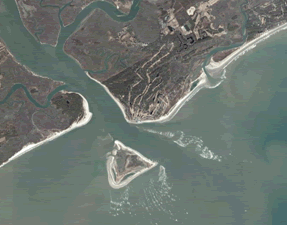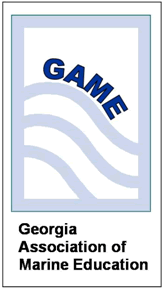 |
||||||||||||
|
2006 |
SCMEA-GAME Joint Conference
Fall
2006
20-22 October
Seabrook
Island, SC
Important Conference News: For those Conference attendees that are staying in cabins, you will need to provide your own bedding (sheets, blanket, pillow; or sleeping bag) and towels. We expect to have no more than 3 persons in a cabin room. Lodge rooms are similar to hotel rooms.
All attendees will want to bring a flashlight (for exploring the beaches and finding your way about easier) and insect repellant. Note that no rooms can be locked when you leave them (can only be locked from the inside, while occuppied), so plan accordingly. St. Christopher is within a gated property.
For additional information on accommodations, go to http://www.stchristopher.org/accomodations__facilities.htm.
Check-in at St. Christopher Conference Center begins at 3:00PM. Those going on the Friday field trip or who would like to stroll the beach and look around or help with Conference setup may come earlier, but you will not be able to get into your room until 3:00PM. Thanks.
 |
For its annual Conference, the South Carolina Marine Educators Association (SCMEA) will join with the Georgia Association of Marine Education (GAME) in a return to the SCMEA Fall schedule (the way it was way back in the 20th century) and to one of our favorite meeting places. It has been a while since we met at the Barrier Island/Camp St. Christopher, so we are looking forward to re-uniting with each other and with our neighboring state in a “Back to the Future” setting. The Conference sessions, meals and events will take place at the Saint Christopher Conference Center on Seabrook Island. The venue and the agenda promises a weekend of learning, fun and an opportunity to immerse yourself in marine science education without distraction (or at least without unwanted distractions).
Beautiful Seabrook Island and the Saint Christopher Conference Center are located 25 miles south of Charleston with accommodations and meeting facilities found among 300 acres of ocean and inlet beach, Spartina saltmarsh and maritime forest. The Conference Center is located at the mouth of the North Edisto River, just north of the ACE Basin National Wildlife Refuge and National Estuarine Research Reserve. In addition to the Conference facilities, the site is the home of the Barrier Island Environmental Education Program, a not-for-profit educational service for public and private school youth. Barrier Island facilities include classrooms, numerous outdoor teaching sites, an arts and crafts building, a climate controlled multi-purpose activity building, a low ropes course, a beach front recreation hall, an activity field, climate controlled beach front cabins with bathrooms, a health center, offices, a full service dining hall , a lighted outdoor recreation field, and over 300 acres of outdoor classroom areas. The site offers exceptional natural beauty and the facilities to enjoy it, as well as access to nearby nature reserves and marine education facilities on Kiawah Island and in the ACE Basin NEER.
The Conference will include opportunities to learn, including hands-on workshops, presentations and a keynote address on marine turtles by Dr. David Owens, Director of the Graduate Program in Marine Biology, College of Charleston. Attendees are invited to join in plenary and concurrent sessions, guided field trips to local marine habitats, planned and unplanned social activities and a generally informative, social and fun weekend.
Accommodations will include a limited number of Lodge Rooms and bunkroom-style cabins. Additional details on accommodations, meals and the conference schedule will be forthcoming, so check back here.
Scholarships are available for SCMEA members to attend the joint Conference, so be sure to check the SCMEA scholarship website for details.
Set aside the weekend of 20-22 October 2006 to meet with new and old friends and colleagues from Georgia and South Carolina, and to be infused with knowledge and ideas.
CLICK
HERE FOR CONFERENCE BROCHURE, REGISTRATION FORM,
TENTATIVE AGENDA AND OTHER DETAILS
Would you like to present at the conference? Choose an option below for a presentation submission form -- just print, fill out, and mail in.
Simple
web (html) form
Word
document (doc) form
CONFERENCE AGENDA
Click here for a printable word document
Friday, October 20
2:00 - 4:00 Field Trip - E/V Discovery. Meet on the beach.
3:00 - 7:00 Registration
-
"The Inside
Story of Sex in the Sea Turtles " - Chapel of the Palms
1:00 - 1:45 SCMEA Business Meeting - Chapel of the Palms
2:00 - 5:00 Concurrent
Field Sessions and Field Trips (see below)
Sunday, October 22
SESSIONS SCHEDULE
E=Elementary, M=Middle, S=Secondary, C=College, G=General, Adm = Administrators, A=All
1-7 = Ocean Literacy Seven Essential Principals addressed; see Addendum for details
Saturday, October 21
SESSION I: CONCURRENT SESSION:
Connecting
People, Community and Environment to Improve Instruction and Learning (A; 4-6)
–
Explore
systems thinking strategies: big picture, cause/effect, long-term, patterns,
mind grooves, and paradigm shifts to improve marine educator/learner
relationships and meaningful instructional connections.
Whale
Sharks, the Galapagos and Gun-Slinging Politics (A; 2,5,6) – Arts and Crafts
Building P
Vicki Soutar,
Should
the
Exploring
Plate Tectonics: A Hands-On Approach (M,
S, C; 1-7) – Chapel of the Palms
Leslie Sautter, Project
Oceanica
Using
puzzles and models, explore some of the basics of the Plate Tectonic Theory,
including seafloor spreading, lithosphere characteristics and subduction.
Interpretive
Methods Outdoors (A; 3-6) – Jamie’s Lodge Rm 30
Diane Wiktorowski,
How
do you interpret the natural world to your students? Explore Freeman Tilden’s six methods of
interpretation through an interactive waterfall, songs, a sensory activity and
a Trail of Beauty.
SESSION II: CONCURRENT SESSION:
FIN-tastic
Fish of
Angela Bliss,
Swim
on in for this entertaining and interactive presentation on some of our fishy
friends. Useful FIN-tastic activities,
NSES curriculum ideas, handouts and DOOR PRIZES!!!
Exploring
the Lost City Hydrothermal Vent Field: A
New Type of Vent System and a New Method of Exploration (A; 1,2,5,7) – Arts and
Crafts Building P
Paula Keener-Chavis,
Explore
the Lost City Hydrothermal Field on the Mid-Atlantic Ridge, a completely new
vent environment unlike any seen before on Earth. Amazing
video and lessons.
The
Natural History of Galapagos Critters (A; 1-5) – Chapel of the Palms
Julie Cliff, Mrs. Cliff’s
Eco-Adventures; Leslie Sautter
Learn
the natural history of the unique creatures of the magical
Problem-Based
Learning in Marine Biology Classes (M, S, C; 1-7) – Jamie’s Lodge Rm 30
John Peters,
SESSION III: CONCURRENT OUTDOOR FIELD SESSION:
S.O.S: Save Our Shorebirds! (E, M; 5-6) – Meet in
Mike Walker,
Through
the hands-on use of tools such as transects, quadrats, core samplers, and water
quality test kits, participants in this standards-based Discover Carolina
program will investigate the biotic and abiotic factors of a coastal ecosystem
as they impact an increasingly threatened group of animals, the shorebirds.
Afterwards, help with a service learning project to protect these rapidly
declining birds.
Let’s
Get
Ann Wilson,
Crawl
through a shrimp net, read a crawl, dig a nest, conduct mock turtle nest
inventories and strandings. Elementary curriculum. No live turtles.
Sunday, October 22
SESSION IV: CONCURRENT SESSION:
Mapping
It Out: Stormwater Runoff in Our
Wetlands (A; 6) -
Karen Fuss, Center for
Marine and Wetlands Studies, Coastal
Stand
up and enjoy a hands-on, interactive mapping activity while experiencing the
watershed approach. Identify land uses and their impacts on our waterways. Learn solutions to reduce nonpoint source
pollution at home and in your community.
Tybee
Turtles (A; 6) - Arts and Crafts Building P
Heather Kozak,
Combine
sunrise walks, conservation, education corporate and community involvement into
one turtle-ific project! Scute in for eggs-travagant ideas and hatch a program of your own.
Discover
Elaine Freeman,
Having
difficulty teaching coastal processes to your students? Then join us for a fun, hands-on field study
demonstrating the dynamic processes that constantly change our coast!
Marine
Science for Students From All Walks of Life (E; 5, 6) - Jamie’s Lodge Rm 30
Anne Lindsay Frick, UGA
Marine Extension Service
Land-lubbers
need marine science experiences to appreciate and become coastal / ocean stewards. The
SESSION V: CONCURRENT SESSION:
Training
Future Science Educators: The
Kathy Kowalchick, SC
Aquarium
In
an effort to encourage minority participation in the sciences, the South
Carolina Aquarium offers high school juniors paid internships during the
summer, to explore new career paths and gain valuable job skills.
Be
Crabby: People Will Notice You (A; 2,4,6)
– Arts And Crafts Building P
Harold E. Oberg
The
“Crabihabitat” is an interactive field- to- lab activity and display that
permits students to learn about and demonstrate the ways that fiddler crabs
become important parts of the coastal marsh and estuarine habitats. Session participants will learn how to
collect field samples to create and maintain classroom displays of living organisms
that help to shape and maintain an ecological balance within the Atlantic
Coastal Marshes.
Ocean
Currents and Circulation in the
Margaret Olsen, Center for
Ocean Science Education Excellence- Southeast; Lundie Spence
Currents Anyone??? COSEE SE, in conjunction with SEACOOS, presents its latest in a series
of awesome posters -- “Circulation”. Come enjoy hands-on activities involving current circulation in the
South Atlantic Bight and receive a free poster for your classroom.
Forever
Slack (S,C,G; 1,2,7) – Jamie’s Lodge Rm 30
Rob Young, Coastal
Slack
tides happen about every 6 ½ hours, right? Hmmm… With this simple classroom activity, we’ll
show you that in the marshes of
SESSION VI: CONCURRENT SESSION:
Marine
Pollution: Environmental Concerns (A) –
Donald W. Sweeper,
Environmental Education Association of
You
Can Publish! (A; 5-6) – Arts and Crafts Building P
Mare Timmons, UGA Marine
Extension Service
Don’t
let your creative ideas go to waste! Perhaps you would like to publish a hands-on activity that you have
designed or tell everyone how unique your classroom methods are. You don’t need to be a great writer to have
your work published. Share your
uniqueness with thousands of people! You
can do it, and I’ll give you some hints on how You Can
Publish! Handouts included.
Experiential
Learning and Tall Ships (E, M, S, C; 1-6) – Chapel of the Palms
Captain Tony Arrow, SC
Maritime Heritage Foundation
This
information session with show how to integrate 5-6th grade science
and math standards into the experiential historic tall ship setting.
Geomorphology
of Dewees Island: Measuring an Mapping
the Beach of A Barrier Island as It Changes Throughout the Course of A Year (G;
2) – Jamie’s Lodge Rm 30
David Betenbaugh, The Deedee Paschal
Barrier
islands are extremely dynamic systems that can change dramatically month to
month. This presentation will introduce
a study that is measuring and mapping the
POSTERS:
The
Al
Segars, SC Department of Natural Resources; Louis D. Heyward,
Sr.
The
ScienceQuest: An After-School Science Experience (A; 1-7)
Katrina Phillips,
ScienceQuest
is an after-school program led by volunteer science undergraduate and graduate
students. It engages middle school
children in hands-on geological and ocean science activities.
SPONSORS
The Members of GAME and SCMEA
Charleston
Kiawah
Island Group Recreation
South Carolina Department of Natural
Resources
Swimming Rockfish & Shrimp Farm
ADDENDUM: OCEAN LITERACY ESSENTIAL PRINCIPLES ADDRESSED BY THIS CONFERENCE
1. The earth
has one big ocean with many features.
2. The ocean
and life in the ocean shape the features of the earth.
3. The ocean
is a major influence on weather and climate.
4. The ocean
makes Earth habitable.
5. The ocean
supports a great diversity of life and ecosystems.
6. The ocean
and humans are interconnected.
7. The ocean
is largely unexplored.
Web Site Hosted by: Project Oceanica, Dept. of Geology College of Charleston, Charleston SC 29412.

